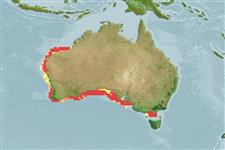ກຸ່ມປາກະດູກອ່ອນ (ເຊັ່ນ: ປາສະຫລາມ, ປາຜາໄລ) (sharks and rays) >
Rhinopristiformes (Shovelnose rays) >
Trygonorrhinidae (Banjo rays, Fiddler rays)
Etymology: Aptychotrema: Greek, a = without + Greek, ptyx, ptychos = fold + Greek, trema = hole (Ref. 45335).
Eponymy: These species and genus are named after the location where the holotypes were caught – the Gulf of St Vincent, near Kangaroo Island, South Australia. (Ref. 128868), visit book page.
Environment: milieu / climate zone / depth range / distribution range
ນິເວດວິທະຍາ
ສັດທະເລ ອາໄສຢູ່ໃກ້ໜ້າດິນໃຕ້ພື້ນທ້ອງນ້ຳ; ລະດັບຄວາມເລິກ ? - 125 m (Ref. 114953). Temperate; 19°S - 40°S, 112°E - 147°E (Ref. 114953)
Eastern Indian Ocean: endemic to western and southern Australia.
ຂະໜາດ / ນ້ຳໜັກ / Age
Maturity: Lm ? range ? - ? cm
Max length : 84.0 cm TL ຕົວຜູ້/ບໍ່ມີເພດ; (Ref. 114953)
Occurs near the shore and on the continental shelf from coastal fringe. Common on sandy beaches and seagrass beds (Ref. 006871, Ref. 114953). Mainly feeds on decapod crustaceans and small bony fishes. Females produces litters up to 16 pups. Maturity size for males at ca. 65 cm TL (Ref. 114953). Juveniles are caught with seines.
Life cycle and mating behavior
ການຈະເລີນເຕັມໄວ | ການສືບພັນ | ການວາງໄຂ່ | ໄຂ່ | ຄວາມດົກຂອງໄຂ່ປາ | ຕົວອ່ອນ
Last, P.R. and J.D. Stevens, 1994. Sharks and rays of Australia. CSIRO, Australia. 513 p. (Ref. 6871)
IUCN Red List Status (Ref. 130435: Version 2024-2)
Threat to humans
Harmless
Human uses
ເຄື່ອງມື
Special reports
Download XML
ແຫຼ່ງອີນເຕີເນັດ
Estimates based on models
Preferred temperature (Ref.
123201): 16.3 - 26.7, mean 18.3 °C (based on 218 cells).
Phylogenetic diversity index (Ref.
82804): PD
50 = 0.6250 [Uniqueness, from 0.5 = low to 2.0 = high].
Bayesian length-weight: a=0.00724 (0.00267 - 0.01964), b=3.00 (2.77 - 3.23), in cm total length, based on LWR estimates for this (Sub)family-body shape (Ref.
93245).
ຊັ້ນເຂດຮ້ອນ (Ref.
69278): 3.6 ±0.6 se; based on size and trophs of closest relatives
ຄວາມຢືດຢຸ່ນ (Ref.
120179): ຕຳ່, ປະຊາກອນຕຳ່ສຸດທີ່ໃຊ້ເວລາສອງເທົ່າ 4.5 - 14 ປີ (Assuming fecundity<100).
Fishing Vulnerability (Ref.
59153): Moderate to high vulnerability (54 of 100).
